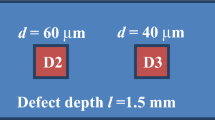Abstract
A life prediction model is developed for crack nucleation and early crack growth based on fatigue, environment (oxidation), and creep damage. The model handles different strain-temperature phasings(i.e., in-phase and out-of-phase thermomechanical fatigue, isothermal fatigue, and others, including nonproportional phasings). Fatigue life predictions compare favorably with experiments in 1070 steel for a wide range of test conditions and strain-temperature phasings. An oxide growth (oxide damage) model is based on the repeated microrupture process of oxide observed from microscopic measurements. A creep damage expression, which is stress-based, is coupled with a unified constitutive equation. A set of interrupted tests was performed to provide valuable damage progression information. Tests were performed in air and in helium atmospheres to isolate creep damage from oxidation damage.
Similar content being viewed by others
References
R.S. Nelson, J.F. Schoendorf, and L.S. Lin:Creep Fatigue Life Prediction for Engine Hot Section Materials (Isotropic)-Interim Report, NASA CR-179550, Dec. 1986.
L.F. Coffin, Jr.:Fatigue at Elevated Temperatures, ASTM STP 520, 1973, pp. 524.
K.D. Challenger, A.K. Miller, and R.L. Langdon:J. Materials for Energy Systems, 1981, vol. 3 (6), pp. 51–61.
S.D. Antolovich, R. Baur, and S. Liu:Superalloys 1980, 1980, pp. 605–13.
S.D. Antolovich, S. Liu, and R. Baur:Metall. Trans. A, 1981, vol. 12A, pp. 473–81.
J. Reuchet and L. Rémy:Metalt. Trans. A, 1983, vol. 14A, pp. 141–49.
R.P. Skelton and J.I. Bucklow:Met. Sci., 1978, vol. 12 (2), pp. 64–70.
A. Saxena and J.L. Bassani:Proc. AIME on Fracture: Inter- actions of Microstructure, Mechanisms, and Mechanics, J.M. Wells and J.D. Landes, eds., 1984, pp. 357–13.
H.W. Liu and Y. Oshida:Theoretical and Applied Fracture Me- chanics, 1986, vol. 6, pp. 85–94.
L.F. Coffin, Jr.:Metall. Trans., 1972, vol. 3, pp. 1777–88.
U.R. Skelton:Mater. Sci. and Eng., 1978, vol. 35 (2), pp. 287–98.
S. Floreen and R.H. Kane:Fatigue of Engineering Materials and Structures, 1980, vol. 2, pp. 401–12.
R.P. Skelton:Low-Cycle Fatigue and Life Prediction, ASTM STP 770, 1982, pp. 337–81.
E. Renner, H. Vehoff, H. Riedel, and P. Neumann:Int. Conf. on Low Cycle Fatigue and Elasto-Plastic Behaviour of Materials, 2nd ed., Munich, Germany, 1987, pp. 277–83.
J. Bressers, U. Schusser, and B. Ilschner:Int. Conf. on Low Cycle Fatigue and Elasto-Plastic Behaviour of Materials, 2nd ed., Munich, Germany, 1987, pp. 365–70.
M. Karasek, H. Sehitoglu, and D. Slavik:Low Cycle Fatigue—Directions for the Future, Proc. ASTM Conf., Lake George, NY, Oct. 1985.
G.R. Halford and J.F. Saltsman:Proc. of ASME Conf. on Ther- mal Stress, Material Deformation, and Thermo-Mechanical Fa- tigue, H. Sehitoglu and S.Y. Zamrik, eds., ASME, New York, NY, 1987, PVP-vol. 123, pp. 9–21.
G.R. Halford and S.S. Manson:Thermal Fatigue of Materials and Components, ASTM STP 612, D. Spera and D. Mowbray, eds., 1976, pp. 239–54.
ASME Boiler and Pressure Vessel Code, Case N-47-23, Class 1 Components in Elevated Temperature Service, Section III, Division 1, 1986.
T. Bui-Quoc and A. Biron:3rd Int. Conf. on Pressure Vessel Technology, Part II, ASME, New York, NY, 1977, pp. 853–60.
M. Bernard-Connolly, A. Biron, and T. Bui-Quoc:Trans. CSME, 1978-79, vol. 5 (3), pp. 173–78.
J. Lemaitre and A. Plumtree:J. Eng. Mater. Tech., Trans. ASME, 1979, vol. 101 (7), pp. 284–92.
A. Plumtree:Can. Metall. Quart., 1979, vol. 18, pp. 197–205.
T. Bui-Quoc and R. Gomuc:ASME Int. Conf. on Advances in Life Prediction Methods, D.A. Woodford and J.R. Whitehead, eds., 1983, pp. 105–13.
J.L. Chaboche: inEngineering Approaches to High Temperature Design, B. Wilshire and D.R.J. Owen, eds., 1983, vol. 2, pp. 177–235.
S. Majumdar and P.S. Maiya:J. Eng. Mater. Tech., 1980, vol. 102 (1), pp. 159–67.
S. Majumdar:Proc. ASME Conf. on Thermal Stress, Material Deformation and Thermo-Mechanical Fatigue, H. Sehitoglu and S.Y. Zamrik, eds., ASME, New York, NY, 1987, PVP-vol. 123, pp. 31–36.
J. Wareing:Metall. Trans. A, 1977, vol. 8A, pp. 711–21.
B. Tomkins:Creep and Fatigue in High Temperature Alloys, J. Bressers, ed., Applied Science Publishers, London, 1981, pp. 111–43.
C.E. Jaske:ASME Int. Conf. on Advances in Life Prediction Methods, 1983, pp. 93–103.
J.K. Tien, S.V. Nair, and V.C. Nardone: inFlow and Fracture at Elevated Temperatures, 1985, pp. 179–213.
C. Levaillant and A. Pineau:Low-Cycle Fatigue and Life Pre- diction, ASTM STP 770, 1982, pp. 169–93.
K.-T. Rie and R.-M. Schmidt:Int. Conf. on Low Cycle Fatigue and Elasto-Plastic Behaviour of Materials, 2nd ed., Munich, Germany, 1987, pp. 223–28.
B.K. Min and R. Raj:Acta Metall., 1978, vol. 26, pp. 1007–22.
S. Baik and R. Raj:Metall. Trans. A, 1982, vol. 13A, pp. 1207–14.
S. Baik and R. Raj:Metall. Trans. A, 1982, vol. 13A, pp. 1215–21.
J. Morrow:Internal Friction, Damping and Cyclic Plasticity, ASTM STP 378, 1965, pp. 45–87.
M.L. Karasek:Materials Engineering-Mechanical Behavior, Re- port No. 132, College of Engineering, University of Illinois at Urbana-Champaign, Urbana, IL, Aug. 1986.
H. Sehitoglu and M. Karasek:J. Eng. Mater. Tech., 1986, vol. 108 (4), pp. 192–98.
G. Ward, B.S. Hockenhull, and P. Hancock:Metall. Trans., 1974, vol. 5, pp. 1451–55.
J.E. Forrest and P.S. Bell:Corrosion and Mechanical Stress at High Temperatures, V. Guttmann and M Merz eds 1981 pp. 339–58.
N. Birks and G.H. Meier:Introduction to High Temperature Oxidation of Metals, Edward Arnold Publishers, London, 1983.
A.S. Argon, I. Chen, and C. Lau:Creep-Fatigue-Environment Interactions, R.M. Pelloux and N.S. Stoloff, eds., TMS-AIME 1980, pp. 46–85.
D. Slavik:Materials Engineering-Mechanical Behavior, Report No. 134, College of Engineering, University of Illinois at Urbana- Champaign, Urbana, IL, Sept. 1986.
D. Slavik and H. Sehitoglu:Proc. ASME Conf. Thermal Stress, Material Deformation, and Thermo-Mechanical Fatigue, H. Sehitoglu and S.Y. Zamrik, eds., ASME, New York, NY 1987, PVP-vol. 123, pp. 65–82.
H. Sehitoglu and J.D. Morrow:Thermal and Environmental Ef- fects in Fatigue: Research-Design Interface, C.E. Jaske, S J Hudak, Jr., and M.E. Mayfield, eds., ASME, New York NY 1983, PVP-vol. 71, pp. 93–109.
H. Sehitoglu:J. Eng. Mater. Tech., 1985 vol 107 (7) pp. 221–26.
Dennis A. Boismier: M.S. Thesis, University of Illinois at Urbana- Champaign, Urbana, IL, 1988.
Author information
Authors and Affiliations
Rights and permissions
About this article
Cite this article
Neu, R.W., Sehitoglu, H. Thermomechanical fatigue, oxidation, and Creep: Part II. Life prediction. Metall Trans A 20, 1769–1783 (1989). https://doi.org/10.1007/BF02663208
Received:
Issue Date:
DOI: https://doi.org/10.1007/BF02663208




